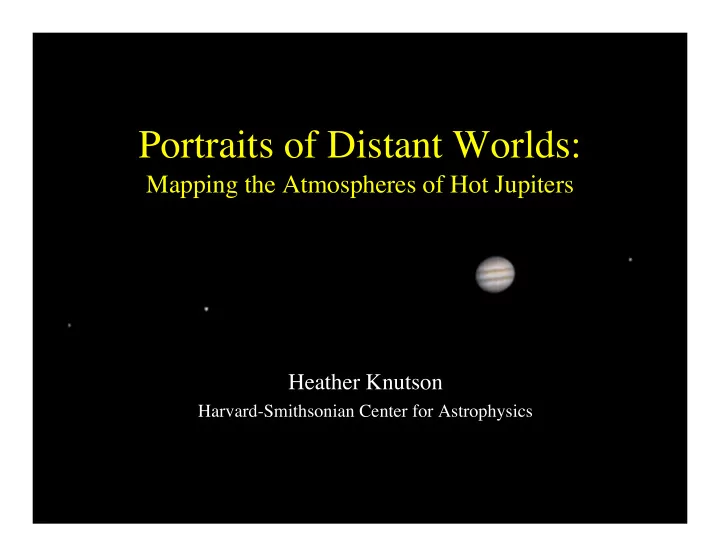

Portraits of Distant Worlds: Mapping the Atmospheres of Hot Jupiters Heather Knutson Harvard-Smithsonian Center for Astrophysics
The Big Question: Atmospheric Circulation? • Hot Jupiters receive ~20,000 times more radiation than Jupiter • What happens to this energy? – Hot day side, cool night side – Strong winds -> equal temperatures • Answer depends on properties of atmosphere (radiative vs. advective timescales) • Models predict a range of possibilities – Showman & Guillot 2002, Cho et al. 2003, Burkert et al. 2005, Cooper & Showman 2005, 2006, Langton & Laughlin 2007, Dobbs-Dixon & Lin 2007 Circulation model for HD 209458b from Cooper & Showman 2005.
Methods for Studying Hot Jupiters Transits Mass-radius relation Transmission spectroscopy Transit timing Phase Curves Day-night temperature contrast Atmospheric dynamics Secondary Eclipses Most difficult type of Emission Spectrum (IR) observation, but also most Albedo (visible light) informative! Eccentricity
What is phase variation? c d b a Observer Hot Jupiters should be tidally locked, so 1 orbit = 1 rotation of planet
Initial Observations Observations of the non- . . . but similar observations of transiting system υ And b at 24 HD 209458b at 8 µ m (Cowan et µ m (Harrington et al. 2006) al. 2007) point to smaller day- seem to indicate large day-night night variations contrast . . . -> Need better-constrained data!
HD 189733b: A More Detailed Look . . . System Geometry What We Observe Grey line: Efficient redistribution of heat from the dayside to the nightside Black: Inefficient heat redistribution, large day-night temperature difference 33 hours of continuous observations at 8 µ m using Image courtesy of Greg Laughlin Spitzer/IRAC (www.oklo.org)
Complications: Star Spots and Detector Effects HD 189733 is a relatively active M dwarf companion K1 star . . . Only 33% of flux in 3.5 pixel aperture comes from corrected pixels! Project variation from spots observed by Measured flux in individual pixels increases Winn et al. (2007) forward 3 months in over time, with shape of ramp determined by time, scale amplitude for 8 µ m illumination level for pixel observations Solution: Derive set of functions describing Conclusion: spots could cause linear shape of ramp as a function of illumination increase in flux with amplitude ~0.1% and correct individual pixels accordingly
HD 189733b: A (Very) Windy Planet • Observed for 33 hours continuously at 8 µm using Spitzer/IRAC – Correct for detector ramp “Whoa, whoa, whoa! They used a – Aperture photometry, radius of 3.5 pixels kajillion dollar instrument to find out • Small size of observed phase the side near the sun is hotter than the variation indicates relatively rest?“ efficient circulation between --anonymous Slashdot user day/night sides – T day =1212 ± 11 K, T night =973 ± 33 K – Requires winds on the order of ~several km/s • Shifted locations of peak and minima also point to strong winds – Peak occurs 16 ± 6 ° before opposition Figure from Knutson, H., Charbonneau, D., Allen, L., Fortney, J., Agol, E., Cowan, N., Showman, A., & Cooper, C. , Nature May 10 2007
Eclipse Photometry Transit Secondary Eclipse • Transit – R P = 1.137±0.006 (±0.020 ) R Jup – 6 s. error on best-fit transit time • Secondary Eclipse – Depth is 0.3381±0.0055% – Secondary eclipse occurs 120 ±24 s later than predicted • Eccentric orbit? e*cos( ϖ ) = 0.0010 ±0.0002
Mapping the Day-Night Contrast
Filling in the Picture: HD 189733b in Emission Charbonneau, Knutson, Barman, Allen, Bouchy, Brown, Mayor, Megeath, Moutou, Queloz, & Udry, in prep. Fluxes are reasonably consistent with predictions from Barman model . . . also MOST upper limit on albedo coming soon.
The Next Steps: Mapping at Two Wavelengths • Why is day-night contrast so large for υ And b and so small for HD 189733b? – Different opacities at 8 vs 24 µ m or different types of atmospheres? • Different wavelengths should probe different depths in atmosphere • Time awarded in Cycle 4 to map HD 189733b at 24 µ m, will allow for direct comparisons between planets Cooper and Showman (2005) model for HD 209458b
The Next Steps: Comparative Exoplanetology Clues to the Inflated Radius Problem? • HD 209458b and υ And b: two of a kind? – HD 209458b has longer period/slower rotation, day side receives 60% more radiation than HD 189733b – υ And b has properties intermediate between these two planets • Will map HD 209458b at 8 and Charbonneau et al. (2007) 24 µm, data set will allow for direct comparisons to HD 189733b at two wavelengths
The Next Steps: Eccentric Planets HAT-P-2b, e = 0.507 HD 80606, e = 0.9321 Figures from Langton & Laughlin (2007, submitted)
Conclusions • For tidally-locked hot Jupiters, models of atmospheric circulation predict a range of possible outcomes • Observations of phase variation constrain the temperature differences between day and night sides – With high signal-to-noise observations, can create a map of temperature as a function of longitude • Transiting planet systems are preferred targets for these observations – Knowledge of planet’s radius and the flux from the dayside needed to accurately interpret relative changes in flux over orbit • Future observations will look at other wavelengths, compare results for different planets, and extend observations to highly eccentric systems
Recommend
More recommend